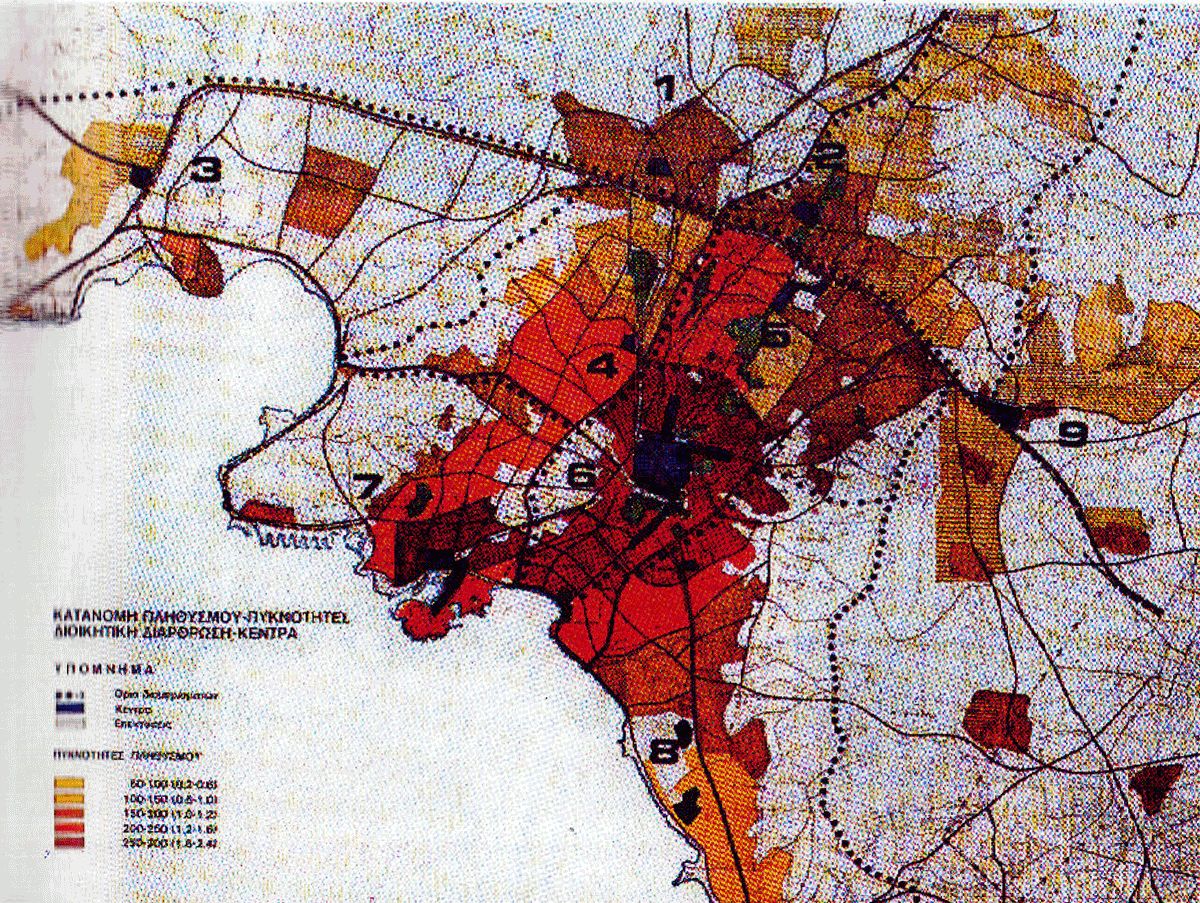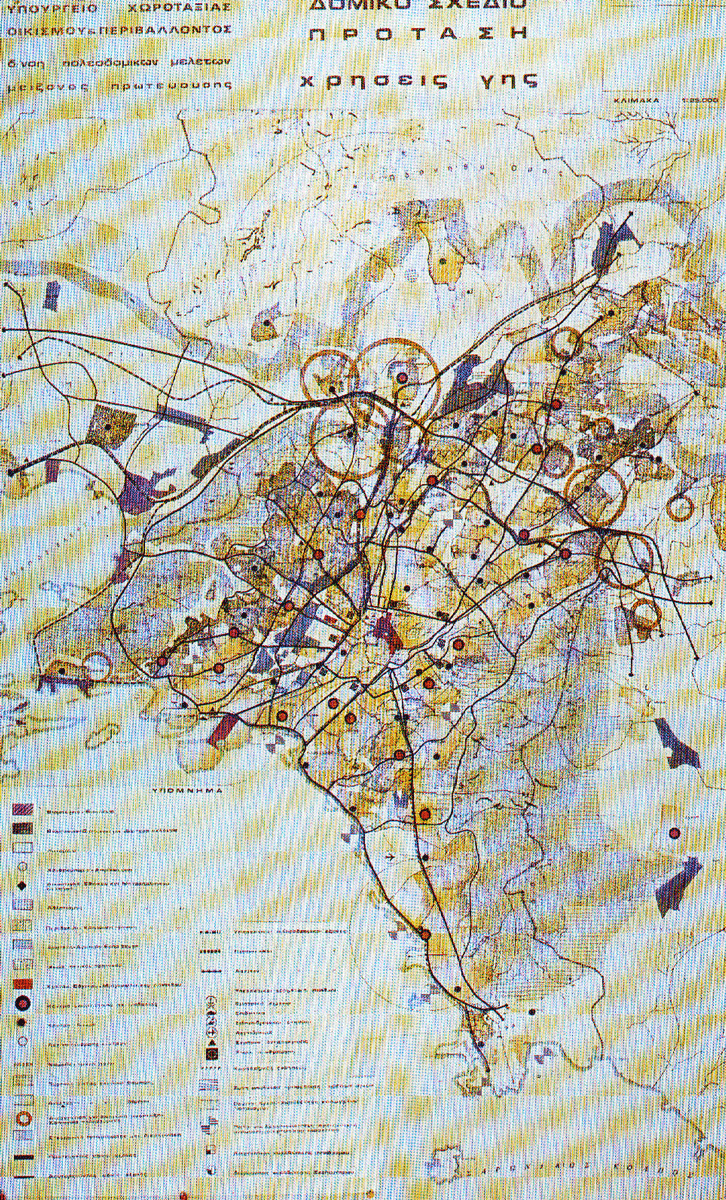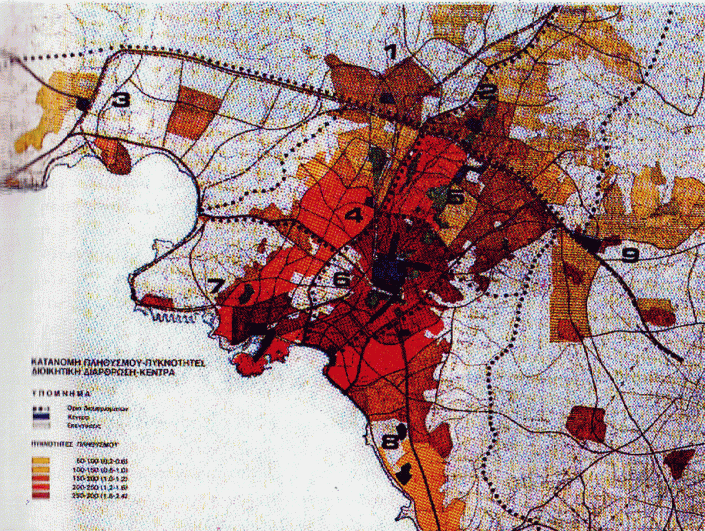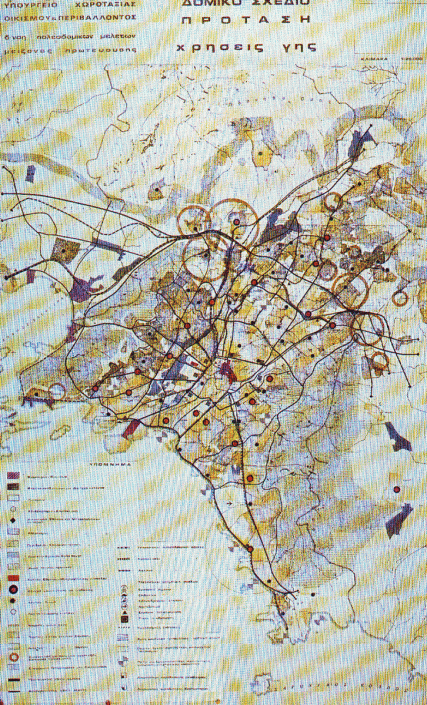The Incomplete Reform: Regulating space in Metapolitefsi Athens 1978–1985
Poulios Dimitris
Planning, Politics
2022 | Sep
The Incomplete Reform: Regulating space in Metapolitefsi Athens 1978–1985
This paper looks into the attempts to regulate the urban space of Athens during the first years of Metapolitefsi (Regime change), focusing on the spatial policies between 1978–1985. The research explores the themes of policy and governance through a threefold prism: First, it studies the “structural context”, that is, the broader economic and social factors influencing the systems of governance. Second, the cultural context, that is, the “ethnic” particularities and institutional traditions that are included in, and shaped by, these systems of governance. Finally, it looks into the roles of political actors, political parties, local pressure groups and movements [1]. In the analysis that follows, we suggest that the relationship and interplay between the three aforementioned sectors shape the entire administration context, and consequently the spatial policies, in Athens.
The questions raised are the following: Which were the factors that defined the “successes and failures” of spatial policy in Athens? How do they correlate with the broader governance system in the city? What role do the political actors play? And how do they affect urban policy?
The Junta Heritage and the Athens “Problem”
Athens will enter the 1970s carrying the heritage of a model of postwar urbanization, which will be expanded during the seven-year dictatorship. To all intents and purposes, the Junta will resume and bolster the same policy of growth and reinforcement of the construction industry (Πρεβελάκης, 2001; Παπαγιάννης, 2019; Οικονόμου, 2002; Φιλιππίδης, 1990) [2]. In the early 1970s, the Attica basin is almost completely urbanized with particularly increased densities at the city center (Αβδελίδη, 2010). The swelling of central neighborhoods will gradually lead to saturation and environmental degradation. At the same time, private car use is generalized, creating intense traffic congestion problems and aggravating air pollution (Ρωμανός, 2004; Πρεβελάκης, 2001). Against this background, Athens starts to lose its appeal, and thus begins the first “exodus” to the city suburbs and the, until then, vacation areas. These trends will also be supported by the institutional frame during the Junta period. Due to the Emergency Law No. 395/68, indexes will increase by 30 per cent, which will provide the green light, as Giorgos Sarigiannis argues, for the urbanization of the suburbs and coastal areas of Attica, following pressures by contractors and landowners (Σαρηγιάννης, 2000) [3]. With the restoration of democracy in 1974, the problems caused by the particular development model of Athens and other Greek cities had now become evident. Air pollution, traffic regulation and the issue of urban planning in general start to occupy a central place in the public debate (Πρεβελάκης, 1984) [4], while a series of natural disasters, such as the floods of 1977, will increase the political pressure to take measures [5]. However, many had doubts at this period that New Democracy was prepared to shoulder the political cost of such initiatives (Παπαγιάννης, 2019.04.08; ΑΝΤΙ, 1980). Between 1978–1980, Kyprianos Biris is succeeded by Stefanos Manos as Undersecretary for Public Works. In the 1980s, under the PASOK administration, Antonis Tritsis served as Minister for Planning, Housing and the Environment.
The attempts at reform on a land policy level where made on these two, different from a point of national government, periods, these of Stefanos Manos and of Antonis Tritsis respectively, are equally important. A study of the reforms, as well as the reasons that led to their failure, will lead us to important conclusions as far as the system of governance is concerned, but also on how urban policies are shaped in Athens.
Photo 1: The cover of ANTI magazine, issue no. 156 (1980), with a special report on the “Athens Problem”
Attempts to regulate the space of Athens (1978-1980)
ΌIn January 1977, when Stefanos Manos took over as Undersecretary, the policies regarding the regulation of space in Athens were mostly shaped on a central level, via the Ministry of Public Works. This centralist system had also been institutionalized by the Constitution of 1974, in which the central government was ascribed responsibilities on issues of urban and spatial planning. The Ministry’s job, up until the first years after the regime change, remarks (2001:53), was “almost totally disassociated with practice”, which was regulated by the market forces as well as the current smaller or larger interests (Σαρηγιάννης, 2000; Φιλιππίδης, 1990; Βοϊβόνδα κ.α., 1977). As states Manos himself, the Undersecretary’s job was to “move roads” and modify the street plan (Μάνος 2018.03.10).
The policy he adopted, assisted by a group of new consultants who were back from working abroad, had strong elements of novelty and modernization [6]: He completed the Regulatory Plan of Athens, which was pending since 1972. He included action plans aiming to upgrade sub-regions. And last, but certainly not least, he legislated a new land policy that would diminish speculation and would protect architectural heritage, while also dictating new terms on planning (Ρωμανός, 2004; Πρεβελάκης, 2001; 1984; Μάνος 2018.03.10).
The Regulatory Plan of Athens will be drawn up by the Ministry of Planning, Housing and the Environment in the period under study. The Framework Plan “Capital City 2000” was the draft guidelines in the context of the national planning policy, the main objective of which was the decongestion of Athens, and secondarily of Thessaloniki, as outlined by the National Council for Planning and the Environment in 1979 (Ρωμανός 2004). Apart from this key principle, the Plan “Capital City 2000” could not boast any particular originality, according to Prevelakis (2001). However, it did set certain important directions on issues of transport infrastructure such as the Metro, on new transport routes, and the Spata airport.
Map 1: The nine districts of the Plan “Capital 2000” where we can see the population density. The Regulatory Plan by Manos was based on the development of Athens along the lines of nine administrative/geographical units that would make up the integration centres for new activities and uses.
Source: Πρεβελάκης, 2001
The action plans for the upgrade of sub-regions consisted of interventions of urban regeneration that started being implemented at the time, such as the pedestrianization of certain streets. Amongst them we could single out the pedestrianization of Voukourestiou street, and notably the total regeneration of Plaka, a process that would be completed in 1986.
The most important initiatives on an urban policy level were taken in the sector of the spatial planning reform, which had a direct impact on Athens. Particularly, in 1979 a decision for the reduction of the plot ratio is implemented, in some cases up to 30 per cent (Μάνος 2018.03.10), while the obligation to create parking spaces in the basements of apartment buildings is introduced (Πρεβελάκης, 1984). However, the defining law of this period was Law 947/79 “on residential areas.” This law attempted to regulate one of the most severe problems of the Greek spatial planning system: The way in which residential areas were integrated to the city plan. Contrary to the past, when this process took place with a large amount of arbitrariness, and under the pressure of various interests, the law established an entirely different frame. According to the law, there had to be a concrete study to justify the expansion, while the infrastructure needs would be covered by the contributions in land and money of the owners themselves. The reactions against the law were immediate, by several networks of owners, constructors etc., and as a result, Stefanos Manos was forced to resign while the implementation of the law was frozen by the government and the new responsible Minister. The next PASOK administration began to develop a new Regulatory Plan.
Photo 2: The cover of Epikaira magazine, with a special report on the Street Plan of Stefanos Manos. The treatment of the, then young, politician as “juvenile”, and “aiming at people’s properties” is an example of oppositional speech regarding the proposed reforms.
Source: Πρεβελάκης, 2001
Urban policy during the first PASOK administration (1981-1985)
PASOK will come to power in October 1981, giving a boost to the democratic turning points that were already taking place and to the income support policy, relying on a “socialist” strategy and an alternative financial plan compared to New Democracy (Καζάκος, 2007; Close, 2006).
A main element of this strategy was the support of the periphery via policies of decentralization, and the decongestion of Athens (Souliotis 2013). This policy, that we already perceive as mainstream since the period of Manos, is associated with a “diffuse hostility towards Athens” (Πυργιώτης, 2019.07.24). This was a view shared by the near entirety of Greek planners at this period (Πρεβελάκης, 2001) and was particularly popular among the parties of the Left. Especially for the Left (PASOK and the two communist parties), the phenomenon of “urbanization” –the urban boosterism of Athens– had distinct associations with the control policies of the post-civil war state and the Right in Greece, as well as the shaping of particular financial interests around the real estate market(Σαρηγιάννης, 2000; Βαϊου και Χατζημιχάλης, 2012).
Hence, PASOK will adopt a series of policies and a series of guidelines aiming to combat the “unnatural inflation” of the capital city. This meant less infrastructure for the city, and the curbing of economic activity. So, the Law 2601/1984 will prohibit the positioning of industries within Attica (Coccossis et al., 2003). The new Regulatory Plan does not include large infrastructure such as the Spata airpost and the Metro (Hastaoglou et al. 1987; Souliotis et al., 2014). It generally follows a logic of containment of the city growth (Ρωμανός, 2004). These particular views were also the positions of Antonis Tritsis, planner, PASOK MP and important figure that defined the spatial policy-making during the first administration of Andreas Papandreou. The Tritsis period will be characterized by a generalization of reforms and an attempt at regulating the space of the whole territory. The greatest turning points of this period were the legislation of the new Residential Law 1337/1983, the Regulatory Plan of Athens 1515/85 and the establishment of ORSA, the Organisation of Planning and Environmental Protection of Athens.
Photo 3: Ministry booklet on the Regulatory Plan of 1983
Source: Papagiannis’s Office
The main difference of the residential law of 1983 compared to Manos’s law (947/79) was the introduction of social criteria to the reimbursement of the land tax, which favored smaller proprietors. Nevertheless, the basic feature and object of this law was the Urban Restructuring Programme (EPA), according to which there would be 428 General Urban Plans implemented in communities all over the country. At the same time, the law includes provisions aiming to contain and regulate illegal construction [7]. This ambitious plan, even though it was well received at the time (Ζέικου, 2015.12.19; Ρωμανός, 2018.1.19), came across serious obstacles to its realization. At first, due to the inefficiencies of the urban planning system itself that could not respond quickly to the new needs that arose (Πυργιώτης, 2019.7.24; Ζέικου, 2015.12.19) due to a lack of expertise, an ignorance regarding the existing situation in the regions faced with the most problems, and so on. For the most part, though, the obstacles were political and derived from the reactions of local communities and landowners to planning and tax issues (Παπαγιάννης, 2019.4.8). The reactions were so strong that in the reshuffling of the government in 1984, Tritsis was removed from the Minister position.
Map 2: The Regulatory Plan of 1985 after the amendments to Law 2730/1999. As opposed to the Plan “Capital City 2000”, the development of the Metropolitan Area is not relegated to nine administrative units, but to a multitude of small or larger centralities consisting a network
Source: NTUA
However, the leadership change in the Ministry did not hinder the institutionalization of the Regulatory Plan of Athens in 1985. The voting of the Regulatory Plan of Athens (RSA) in 1985 along with the establishment of ORSA with Law 1515/1985 was undoubtedly an important institutional moment for the city, as for the first time it enshrined a framework for its future development (Pagonis, 2013; Οικονόμου, 2000; Τριάντης, 2017). However, as it turned out in practice, there were many problems to the application of the RSA and to the operation of ORSA (Ψυχογιός, 2019.3.7; Ζέικου, 2015.12.19; Οικονόμου, 2000; Ρωμανός, 2004), to such a degree that Aristeidis Romanos would suggest that it is doubtful “whether there is another law that was revoked to such a degree, both in practice and due to the administrative inability to act” (Ρωμανός, 2004: 154). The main issues could be condensed to the following:
- There was no connection to the level of financial planning, leading to an inability to find resources for the implementation of the plan (Οικονόμου, 2000; Ρωμανός, 2004) [8]. Furthermore, there was the inability to perform a coordinating role, mostly by ORSA (Οικονόμου, 2000; Ζέικου, 2015.12.19). This is related to the governance structure, to the responsibility overlap, but also to the minister-centric system, that lead to political dependencies and the limitation of the self-determination of organizations such as ORSA and later ORTHE (Ζέικου, 2015.12.19).
- Finally, the binding nature of the application of RSA and its relationship with the underlying design, as a result of the jurisprudence of the Council of State, would also cause severe problems (Οικονόμου, 2000)
Shortly thereafter, the plan was rescinded and modified.
Conclusions – Comments on the reforms of 1974–1985
The removal of Tritsis in 1984, as well as the resignation of Manos in 1980, are indications of an overarching failure to launch any reform attempt on a land policy level, an indispensable prerequisite for policy making both in Athens and the whole country. The inability to implement authorized plans and laws in the interval that followed comes to corroborate it.
First, we have to point out that a series of external factors, such as the economic crisis in the 1970s and the efforts for unification with the rest of Europe, formed the basis and the pressure apparatuses for the conveyance of policies and ideas on a national and local level. But the implementation of these policies was influenced by the local conditions and particularities. This “Athenian exception” (Παγώνης, 2005), was precisely created due to this combination of local actors and the circumstances (local and global) under which they operated.
Specifically in Athens, we maintain that the role of the local actors was central to the policy making and the decision making (agency centered). This is a side effect of centralism that we also see in the case of other countries (Andreotti et al. 2001), where the efforts for overall control lead both to the development of customer relationships and corruption in the private sector, and to the establishment of equally strong networks and parochial tendencies.
But who are these local networks and actors? We can identify two main levels:
On a first level, we should mention the mechanisms and the central administration networks, the responsible ministries and most of all the Ministry of the Environment, Physical Planning and Public Works of the day. The entire decision-making system was determined by the current Minister and ministerial office, i.e. the groups of consultants that form around the Minister (Ζέικου, 2015.12.19; Παπαγιάννης, 2019.8.4; Κλουτσινιώτη, 2016.8.1; Ψυχογιός, 2019.3.7; Πυργιώτης, 2019.7.24; Ρωμανός, 2018.1.19 ) [9].
On a second level, we have a large number of diverse interest groups: trade unions, professional and business associations, scientific bodies, civil society organizations as well as private enterprises and corporate groups, that functioned as lobbies and operated on a national level (TEE, SEB, SETE etc.) but also had power on a local level.
Depending on the case, these networks operated on a case-by-case basis; as allies in political parties, and of course based on the broader economic and social conditions. Essentially, on a local scale, the clientelist networks were restructured in Metapolitefsi (Chorianopoulos, 2012; Lyberaki and Tsakalotos, 2002) [10]. That was very important, as the access of these precise networks to central power, either by promoting or by undermining policies, it was crucial for policy implementation. So, the period between 1974-1985 was defined by the interdependency and the friction between the aforementioned levels. This is the broader context in which every policy was shaped.
The progress of these policies was linked to the inability to control the vested interests and clientelist networks that were mostly operating around the real estate market, both by New Democracy and by PASOK (Παπαγιάννης, 2019.8.4; Πρεβελάκης, 1984). It should be understood that for this particular system, the time and way of integrating properties to the City Plan were decisive, and for this reason the related laws, both Law 947/79 and Law 1337/83, were at the center of attention. The resilience of these mechanisms became obvious by the reactions both in Manos’s and Tritsis’s period [11]. The reactions showcase the reluctance of large parts of society to accept changes that would shake the until then established practices relating to small ownership and the different interests pertaining to landed property [12], but also to the inability to modernize the construction industry. Furthermore, these reactions could be considered as the first stages of a transitive consensus on the part of power parties (Γιαννακούρου και Καυκαλάς, 2014; Γιαννακούρου, 2019.6.25; Λυγερός, 2011).
However, we should also take into account a different series of factors that were related to the general Athens governance system. The first was the inability of experts to comprehend the real tendencies of development in Athens, and more broadly the course of post-war urbanization (Πρεβελάκης, 2001; Hastaoglou et al., 1987). The estimates for a population increase at the capital city were incorrect, as in the 1980s we witnessed a clear stabilization. The crisis in the 1970s caused the social mobility model of the former decades to waver (Μαλούτας 2018). The result of this process was the urban diffusion of Athens, and of other big urban centers in the provinces, that was institutionalized via “generous” expansions of the city plans. Then, there was the inability of the state apparatus itself to cope with the demands of planning and the technical needs that arose (Ζέικου, 2015.12.19; Πυργιώτης, 2019.7.24) [13]. Hence, in the 1980s, we start to see the consolidation of the basic character of the Athens administration system-regime that prevailed in the coming period: the prominent role of the private sector in the production of space, the inability to establish institutional control and policy making, but also the political “reluctance” of a particularly centralist model of city administration.
[1] This particular methodology is mostly based on neo-institutional approaches to the study of urban policies (Peters 2005; 1998; Pierre 1999; 2005; Lowndes 2009; Pierre 1998) as well as on thought patterns that focus on the role of policy and of political subjects in shaping policies (P. Kantor, Savitch, and Haddock, 1997; Paul Kantor and Savitch, 2005; Sellers, 2002; DiGaetano and Strom, 2003).
[2] The contribution of this particular sector after all was critical for Greek economy in its entirety for the whole duration of the 1960s. During the period between 1965–1969, housing investments take up about 40 per cent of the total private investment and constitute 9 to 10 per cent of the total GDP (Τριανταφυλλίδης, 1972). While in 1971, Greece ranked first worldwide in the construction of new housing per 1,000 people (Hastaoglou et al., 1987).
[3] However, this gradually became obvious much later, by the late 1980s.
[4] In May 1976, Kathimerini writes that “the problems of planning, the urban environment and daily life in the cities are nearing a crisis.” ANTI magazine makes a special report on Athens, where we read that “Athens is an indescribable city. The quality of life, degrading on a daily basis, has become dangerously problematic.” (ΑΝΤΙ 1980)
[5] Naturally, there were great challenges. The main problem, notes Kostas Sofoulis, was, on one hand, how to tame the “monster of the constructing industry”, and all the financial networks built around it, and, on the other, how to uproot the notion, which was widespread in broad strata of Greek society, that “money is made in land” (Σοφούλης, 1976).
[6] In fact, attempts for modernization of the framework had begun since 1974, on the initiative of Kyprianos Biris (Σαρηγιάννης, 2000)
[7] The provisions of Law 1337/1983 on unauthorized construction include a series of provisions, combining various tools to deal with unauthorized construction, such as demolitions and expropriations as well as a legitimization framework. It is estimated that the Ministry’s plan anticipated the demolition of more than 3,000 illegal buildings, which however was not actualized.
[8] This became mostly clear on the General Urban Plan level, where there was an inability to provide resources for the necessary expropriations and the formation of social infrastructure.
[9] We should make a special reference to these groups and networks of technical advisers, deriving mostly from the private, but also from the public sector. We refer to scholars, academics and generally “knowledge holders” (Giannakourou, 2011) that advised the public administration in various ways.
[10] Municipalities were particularly vulnerable to pressure, which in many cases led also to the circumvention of the legislative framework (Γιαννακούρου, 2019).
[11] Tritsis himself would attribute the failure of the Ministry’s measures to vested interests. The “confusion,” he maintains, “was caused mainly by the people’s disinformation by interests that were in charge of housing and the environment, and still consider them their private business, i.e. big construction companies, landowners, land-grabbers, building associations, groups of contractors in charge of unauthorized constructions etc.” (Καθημερινή 1984)».
[12] The results of these pressures will become apparent in the dramatic drop of PASOK’s rates in Athens, from 47 per cent to 37.1 per cent (Hastaoglou et al., 1987)
According to Zeikou, former Planning director at the Ministry for the Environment, Energy and Climate Change, “time was wasted due to the lack of technical infrastructure (land registry, backgrounds) … a lot of time and money was wasted on the direction of briefing backgrounds. That decade was wasted in all that”
Entry citation
Poulios, D. (2022) The Incomplete Reform: Regulating space in Metapolitefsi Athens 1978–1985, in Maloutas T., Spyrellis S. (eds) Athens Social Atlas. Digital compendium of texts and visual material. URL: https://www.athenssocialatlas.gr/en/article/the-incomplete-reform-of-athens-in-metapolitefsi/ , DOI: 10.17902/20971.110
Atlas citation
Maloutas T., Spyrellis S. (eds) (2015) Athens Social Atlas. Digital compendium of texts and visual material. URL: https://www.athenssocialatlas.gr/en/ , DOI: 10.17902/20971.9
References
- Andreotti A, Garcia M, Gomez A, Hespanha P, Kazepo Y, and Mingione E (2001) ‘Does a Southern European Model Exist?’ Journal of European Area Studies 9 (1): 43–62. https://doi.org/10.1080/14608460120061948.
- Chorianopoulos I (2012) ‘State Spatial Restructuring in Greece: Forced Rescaling, Unresponsive Localities’. European Urban and Regional Studies 19 (4): 331–48. https://doi.org/10.1177/0969776411430351.
- Close D (2006) Ελλάδα 1945-2004: Πολιτική, Κοινωνία, Οικονομία. Αθήνα: Θυραθεν. https://www.politeianet.gr/books/9789608097308-close-h-david-thurathen-ellada-1945-2004-203393.
- DiGaetano A and Strom E (2003) ‘Comparative Urban Governance: An Integrated Approach’. Urban Affairs Review 38 (3): 356–95. https://doi.org/10.1177/1078087402238806.
- Giannakourou G (2011) ‘Europeanization, Actor Constellations and Spatial Policy Change in Greece’. DisP – The Planning Review 47 (186): 32–41.
- Hastaoglou V, Hadjimichalis C, Kalogirou N, and Papamichos N (1987) ‘Urbanisation, Crisis and Urban Policy in Greece’. Antipode 19 (2): 154–77.
- Kantor P, Savitch HV and Haddock CH (1997) ‘The Political Economy of Urban Regimes: A Comparative Perspective’. Urban Affairs Review 32 (3): 348–77.
- Kantor P and Savitch HV (2005) ‘How to Study Comparative Urban Development Politics: A Research Note’. International Journal of Urban and Regional Research 29 (1): 135–51. https://doi.org/10.1111/j.1468-2427.2005.00575.x.
- Lowndes V (2009) ‘New Institutionalism and Urban Politics’. In Theories of Urban Politics, edited by Jonathan S Davies and David L Imbroscio. Los Angeles: Sage.
- Lyberaki A and Euclid T (2002) ‘Reforming the Economy without Society: Social and Institutional Constraints to Economic Reform in Post-1974 Greece’. New Political Economy 7 (1): 93–114. https://doi.org/10.1080/13563460120115534.
- Pagonis (2013) ‘The Evolution of Metropolitan Planning Policy in Athens over the Last Three Decades: Linking Shifts in the Planning Discourse with Institutional Changes and Spatial Transformation’. In Changing Cities: Spatial, morphological, formal and socioeconomic dimensions Conference. University of Thessaly . Skiathos: University of Thessaly.
- Peters, BG (1998) ‘Political Institutions, Old and New – Oxford Scholarship’. In A New Handbook of Political Science, edited by Robert Goodin and Hans-Dieter Klingemann. UK: Oxford University Press. http://www.oxfordscholarship.com/view/10.1093/0198294719.001.0001/acprof-9780198294719-chapter-7.
- Peters, BG (2005) Institutional Theory in Political Science: 2nd Edition. 2 edition. London ; New York: Bloomsbury Academic.
- Pierre J (1998) Partnerships in Urban Governance: European and American Experiences. 1998 edition. New York: Palgrave Macmillan.
- Pierre J (1999) ‘Models of Urban Governance: The Institutional Dimension of Urban Politics’. Urban Affairs Review 34 (3): 372–96..
- Pierre J (2005) ‘Comparative Urban Governance: Uncovering Complex Causalities’. Urban Affairs Review 40 (4): 446–62.
- Sellers JM (2002) ‘The Nation-State and Urban Governance: Toward Multilevel Analysis’. Urban Affairs Review 37 (5): 611–41.
- Souliotis N (2013) ‘Athens and the Politics of the Sovereign Debt Crisis’. In Fujita K (eds) Cities and Crisis: New Critical Urban Theory. London: SAGE.
- Souliotis Ν, Sayas J and Maloutas T (2014) ‘Megaprojects, Neoliberalization, and State Capacities: Assessing the Medium-Term Impact of the 2004 Olympic Games on Athenian Urban Policies’. Environment and Planning C: Government and Policy 32.
- Αβδελίδη Κ (2010) ‘Η Χωρική Εξέλιξη 4 Μεγάλων Ελληνικών Πόλεων’. Αθήνα: ΕΚΚΕ.
- ΑΝΤΙ (1980) ‘Το Πρόβλημα Αθήνα’. ANTI, 1980.
- Βαϊου Ν και Χατζημιχάλης Κ (2012) Ο Χώρος Στην Αριστερή Σκέψη. Αθήνα: Ινστιτούτο Νίκος Πουλαντζας / Νήσος.
- Βοϊβόνδα Α, Κλουτσινιώτη Α, Κονταράτου Α και Πυργιώτης Γ (1977) ‘Η Ρύθμιση Του Χώρου Στην Ελλάδα’. Αρχιτεκτονικά Θέματα, τ. 11: 128–93.
- Γιαννακούρου Γ και Καυκαλάς Γ (2014) ‘Επανεξετάζοντας Τη Χωροταξία Σε Περίοδο Κρίσης: Αναγκαιότητα, Περιεχόμενο Και Προϋποθέσεις Της Μεταρρύθμισης’. Στο Μασουράκης Μ και Γκόρτσος Χ (επ) Ανταγωνιστικότητα Για Ανάπτυξη: Προτάσεις Πολιτικής. Αθήνα: Ελληνική Ένωση Τραπεζών. 511–22
- Καζάκος Π (2007) Ανάμεσα Σε Κράτος Και Αγορά: Οικονομία Και Οικονομική Πολιτική Στη Μεταπολεμική Ελλάδα 1944-2000. Αθήνα: Εκδόσεις Πατάκη.
- Λυγερός (2011) Από Την Κλεπτοκρατία Στην Χρεοκοπία. Αθήνα: Πατάκη.
- Μαλούτας Θ (2018) Η Κοινωνική Γεωγραφία Της Αθήνας: Κοινωνικές Ομάδες Και Δομημένο Περιβάλλον Σε Μια Νοτιευρωπαϊκή Μητρόπολη. Αθήνα: Αλεξάνδρεια.
- Οικονόμου Δ (2000) ‘Το Ρυθμιστικό Σχέδιο Της Αθήνας: Εμπειρίες Και Προοπτικές’. Στο Ψυχάρης Γ κ.α. (επ) Δεκαεπτά Κείμενα Για Το Σχεδιασμό, Τις Πόλεις Και Την Ανάπτυξη. Βόλος: Πανεπιστημιακές Εκδόσεις Θεσσαλίας. 161–95
- Παγώνης Α (2005) ‘Ολυμπιακή Και Μέτα-Ολυμπιακή Αθηναϊκή Πολεοδομία. Η Μετατόπιση Της Συλλογιστικής Του Σχεδιασμού Του Χώρου Ως Συνέπεια Του Κατακερματισμού Των Δομών Αρμοδιότητας. Διδακτορική Διατριβή. Σχολή Αρχιτεκτόνων Μηχανικών ΕΜΠ: Αθήνα
- Πούλιος Δ (2021) «Πόλεις σε κρίση: πολιτικές, πολιτικά υποκείμενα, διακυβέρνηση και πολεοδομική πρακτική στην Αθήνα και τη Βαρκελώνη (2007-2019): μεθοδολογία και κριτήρια ανάλυσης Αστικών Πολιτικών». Διδακτορική Διατριβή. Αθήνα: ΕΜΠ http://hdl.handle.net/10442/hedi/49917
- Πρεβελάκης Γ (1984) ‘Πρόσφατες Προσπάθειες Για Την Οργάνωση Του Αστικού Χώρου Στην Ελλάδα (η Πολεοδομική Και Οικιστική Πολιτική Της Περιόδου 1978-1980)’. Στο: Αραβαντίνος Α (επ) Πολεοδομικός Σχεδιασμός, Θέματα Από Την Θεωρία Και Την Πρακτική. Αθήνα: ΕΜΠ.
- Πρεβελάκης Γ (2001) Επιστροφή Στην Αθήνα: Πολεοδομία Και Γεωπολιτική Της Ελληνικής Πρωτεύουσας. Αθήνα: ΕΣΤΙΑ.
- Ρωμανός Α (2004) Αθήνα: Το Πολεοδομικό Ζήτημα Απο Τη Σκοπιά Του Πολίτη. Αθήνα: Ποταμός.
- Σαρηγιάννης Γ (2000) Αθήνα 1830-2000: Εξέλιξη, Πολεοδομία, Μεταφορές. Αθήνα: Συμμετρία.
- Σοφούλης Κ (1976) “‘Ποιός Ελέγχει Την “Παραγωγή” Των Αστικών Εδαφών Μας’” Καθημερινή, 6 Ιουνίου 1976.
- Τριανταφυλλίδης Κ (1972) ‘Η Στεγαστική Δραστηριότης Ως Αναπτυξιακός Παράγων Εν Τη Ελληνική Οικονομία’. Τεχνικά Χρονικά, 579–89.
- Τριάντης Λ (2017) ‘Το Θεσμικό Πλαίσιο Του Χωρικού Σχεδιασμού Για Το Κέντρο Της Αθήνας: Όψεις Του Στρατηγικού Και Του Κανονιστικού Σχεδιασμού’. Κοινωνικός Άτλαντας Της Αθήνας. Ηλεκτρονική Συλλογή Κειμένων Και Εποπτικού Υλικού Https://www.Athenssocialatlas.Gr/En/Article/Spatial–Planning/.
- Φιλιππίδης Δ (1990) Για Την Ελληνική Πόλη. Αθήνα: Θεμέλιο.









